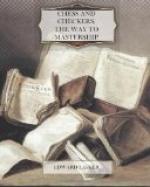(20)
Pxf3 Bxh2+
(21)
K-g2
+---------------------------------------+ 8 | | | | #R | | #R | #K | | |---------------------------------------| 7 | | | #Q | | | #P | #P | | |---------------------------------------| 6 | #P | | | | | | | #P | |---------------------------------------| 5 | | #P | | | | | | | |---------------------------------------| 4 | | | | | | | | | |---------------------------------------| 3 | | ^P | ^P | | | ^P | | | |---------------------------------------| 2 | | ^P | ^Q | ^B | | ^P | ^K | ^B | |---------------------------------------| 1 | ^R | | | | ^R | | | | +---------------------------------------+ a b c d e f g h
Diagram 68.
A general survey of the position shows clearly that Black has the advantage. His Rook d8 is ready to take part in the battle while White has to make several preparatory moves with his Rooks before he can make use of them on the King’s wing, the only part of the board where they have a chance to be effective. In the e-line which White’s Rook controls at present, there is no tangible object for an attack.
Moreover, White’s King is rather exposed while Black’s King is safely entrenched behind his Pawns.
A good continuation for Black, which presents itself at first thought, is R-d6, enabling the doubling of the Rooks in the d-line or the participation of the Rook d6 in a fight on the King’s wing.
(21)
... R-d6
(22)
R-e4
White cannot take the Bishop h2 as Rxd2 would win the Queen. (22) P-f4 would not be good either as Black would reply Q-d7, threatening Rxd2 as well as Q-g4+; Kxh2, R-g6 and mate in two moves.
With R-e4 White attempts to protect his King by R-g4 against attacks in the g-file, and Black naturally tries to foil this attempt.
(22)
... P-f5
(23)
R-h4
Black has now to decide whether he should withdraw his Bishop to e5 or counterattack White’s Bishop by Q-d7 or Q-d8 or Rf8-d8. The counterattack looks better as it threatens to force an entrance for the Rooks in the second rank, displacing White’s Queen and attacking the King from the flank. The withdrawal of the Bishop would give White time to play his Queen’s Rook over to the King’s wing.
The most forcible of the three moves available for the counterattack is Q-d8, which attacks the Rook h4 too, thereby depriving White of the possibility to save his Bishop by flight.
(23)
... Q-d8
(24)
Rxh2 Rxd2
(25)
Q-c1
White’s Queen has now hardly any mobility and in addition she shuts off the Queen’s Rook from the King’s wing. Black, on the other hand, can easily get his Rooks to cooperate by doubling them either in the d-file or in the second rank. He decides on the former alternative because the control of the Queen’s file keeps White’s troops separated in two parts which have little or no communication with each other, while Black’s pieces are ready for concentration on the King’s wing at any moment.




